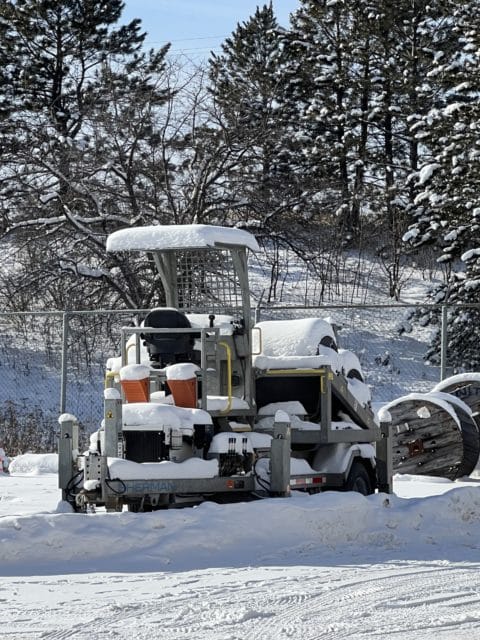Care and maintenance of your Sherman+Reilly pullers, tensioners, pilot line winders, and Duct Dawgs improves performance, improves safety, and improves jobsite efficiency. Conducting frequent and proper inspections of bullwheels, drums, drive engagements, arbors, levelwinds, engines, hydraulics, and other peripheral equipment can identify potential problems that could later cause jobsite downtime. For optimal performance of your utility line stringing equipment conduct winterization on your equipment before the cold weather hits! We recommend you add these winterization preventive maintenance actions to your maintenance schedule, and thank you for choosing Sherman+Reilly!
Need assistance? Our expert service team is here to help.
Here’s a handy winterization checklist to get you started:
1. Test engine coolant and replace or fill with 50/50 antifreeze and distilled water mixture to prevent freeze damage.
2. Adjust oil weight according to average temperature expected during use.

3. Drain and refill fuel tank with winter grade diesel.
4. Verify that all glow plugs are in good condition. If only one glow plug is bad, it will prevent the engine from starting.
5. Inspect and ensure any equipped fluid, block, battery, or air heaters are working properly and repair or replace accordingly.
6. Before the cold temperatures set in, you should clean and inspect the battery, cables, terminals, tray and hold- downs. Also check the battery case for leaks and cracks. To prevent damage caused by self-discharging and keep the battery charged and ready all year, you can connect a trickle charger/battery maintainer without the risk overcharging while left on the battery for long periods of time.
7. Never use starting fluids of any kind. Severe damage to the piston rings or ring lands can be caused using starting fluids.
8. If equipped, keep DEF above 40°F and in an insulated cabinet. DEF fluid generally freezes at 12°F and increases in volume by 7%. If the DEF tank on the machine is frozen consult the engine manufacturer manual on thawing procedure.
9. It's also recommended to check inside the engine compartment for debris. Open and inspect compartment latches, and be sure to close and re-secure all engine covers and panels properly before transporting or operating the machine.
10. Inspect drum surfaces for damage or excessive wear.
11. Check hydraulic systems, including the pump, drive motors, and hoses for loose fittings, leaking fluids, and damaged hoses.
12. Inspect all equipment grounds for any signs of damage.
13. Do an overall damage check of your utility line stringing equipment to see if there are any bent or broken parts, cracked or broken welds, and/or missing pins and retainers.
14. Examine all jacks for damage or leaking hydraulic components.
15. Inspect connected reel stands, drive motors, drive bars, drive pins, and reel shaft couplings to ensure they are secure and there are no obvious signs of damage. If damaged, do not operate. Service may be required.
16. Check fairleads and rollers for any signs of damage and make sure rollers move freely.

Please note: these guidelines are not all-inclusive and are provided to assist in identifying maintenance items and areas to be considered. Harsh climate and various operational conditions may necessitate additional considerations. For specific engine preventative maintenance, Sherman+Reilly recommends following the engine manufacturer’s guidance. In any instance where the S+R guidance is different than the engine manufacturer’s guidance, the engine manufacturer’s guidance should take precedence.
We are honored you chose Sherman+Reilly for your utility line stringing equipment needs and we look forward to serving you.
If you have any questions about service, feel free to contact us at [email protected], 423-756-5300 or click the button below for more information about our service department.
